A U.S. T48 FAL 7.62mm rifle manufactured by Harrington & Richardson. 500 of these rifles were manufactured to compete with the U.S. designed T44E4 (M14) rifle.
By Frank Iannamico
The service life of the famous Belgian designed Fusil Automatique Leger or FN FAL 7.62mm rifle has eclipsed for most of the ninety-plus nations that adopted the weapon during the 1950s. As a first line infantry weapon, the old workhorse FAL has largely been replaced by more modern small-arms.
Back during the 1980s new Belgian made FN FAL semiautomatic rifles, designated as the LAR (Light Automatic Rifle), were imported specifically for the U.S. civilian market. While the Belgian made rifles were extremely accurate and very well made, they were quite expensive; costing nearly twice as much as a semiautomatic Colt AR-15.
The world wide retirement of the FN FAL rifle has provided many parts and part sets for enthusiasts, and has created a substantial market for U.S. made receivers. FN FAL rifles built on American made receivers have been reasonably priced and extremely popular.
A Brief FAL History
During the post World War II era many of the allied nations began to search for a modern infantry rifle to replace their aging small-arms, many of which were long-obsolete bolt action rifles. The NATO alliance, formed in 1949, was set up largely to discourage an attack by the Soviet Union on the non-Communist nations of Western Europe. The NATO members decided that one of the joint military items that needed to be standardized was small arms ammunition. The action was taken to prevent the supply problems all nations had encountered during World War II and Korea. The selection of a service rifle was left up to each individual country: most chose the FAL.
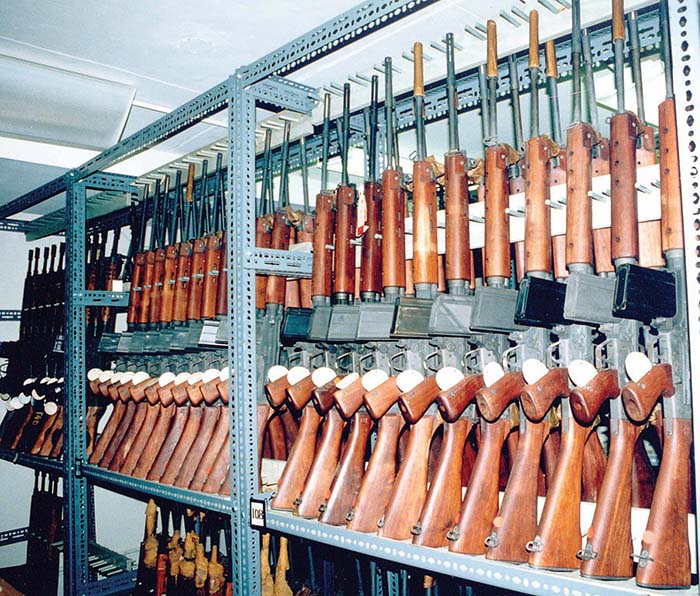
The Belgian FAL rifle was designed by a Fabrique Nationale factory design team headed by Dieudonne Saive. The original FAL prototype rifle introduced in 1948 was chambered for the midrange 8mm Kurz round first fielded by German forces near the war’s end. Subsequent prototypes were chambered for the experimental British .280 cartridge.
The controversial NATO standard cartridge selection program ended with the adoption of the U.S. developed 7.62×51 cartridge in January of 1954. Anticipating the NATO adoption of the U.S. endorsed 7.62×51 round, efforts by Dieudonne Saive and Ernest Vervier began as early as 1952 to adapt the FAL rifle for the U.S. cartridge. The resulting 7.62mm weapon was considerably longer and heavier than earlier variations.
From 1952 through 1956, many of the NATO alliance countries began to seriously consider the Belgian rifle. Canada was the first NATO country to officially adopt the FAL rifle in July of 1953. Since the FN FAL rifle was built using the metric system, the Canadian Government was the first to address the challenge of converting the drawings from metric to inches. Later that year, the United States ordered 3,000 standard and 200 heavy barrel metric FAL rifles from Fabrique Nationale in Belgium. The Belgian made rifles were designated as the T48. While the United States began work on making an inch-pattern U.S. manufactured FAL rifle, the Belgian made T48 weapons were issued to the U.S. Army for field testing. During 1954 Great Britain also ordered a number of the FAL rifles chambered for the new 7.62 NATO cartridge for testing.
A meeting was held at the Office of the U.S. Chief of Ordnance on 10 May 1954 in order to brief representatives of the Springfield Armory on the policy for the T48 rifle program. On 26 May 1954 Armory officials attended a conference held at the head office of Canadian Arsenals Limited. The purpose of the Canadian meeting was to participate in what was called the American-British-Canadian Program (A-B-C) to convert the metric FN FAL drawings to American Standards. The group distributed translated drawings and manufacturing data to prospective contractors who were invited to submit bids for production studies. It was established that engineering information would be exchanged between the United States, Great Britain and Canada with Canadian Arsenals Ltd. acting as the clearing house. Spare parts requirements for a normal one-year maintenance program were compiled for the 500 T48 rifles to be manufactured in the United States.
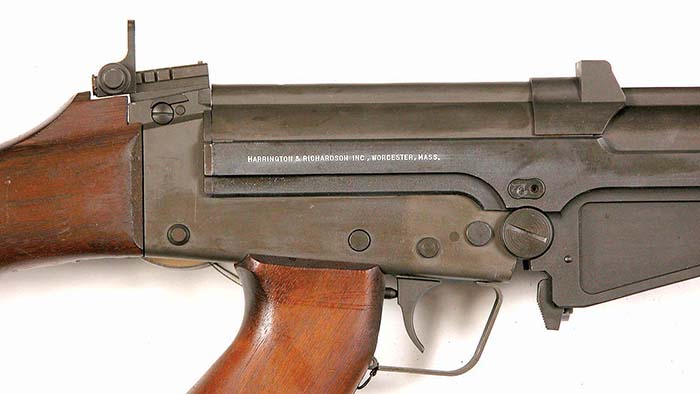
After a brief study it was determined that converting the metric Belgian drawings to inches would not be an easy task. Other concerns were U.S. Ordnance specifications for materials, heat-treating procedures, manufacturing tolerances and other manufacturing operations. Personnel from the U.S. Springfield Armory were originally assigned the job of converting the FAL manufacturing drawings. However, since the Springfield Armory was busy with the T44E4 rifle development and numerous other projects, it was decided to turn the job over to a commercial entity. Bids were taken for the project and the contract was eventually awarded to the High Standard Company. As part of the agreement, High Standard was to manufacture twelve functional FAL T48 rifles from their final drawings and were to be delivered by September of 1954. The U.S. FAL, the T48, adopted the Canadian improved magazine design that included a reinforced magazine lip. This modification made to all inch-pattern FAL rifle magazines, made the magazine non-interchangeable with metric FAL rifles. The first U.S. made T48 FAL rifle was fired at the Springfield Armory on 9 May 1955. Despite the fact that there was no formal contract between Fabrique Nationale and the United States, the company granted the U.S. at no cost, the complete rights to produce the FN T48 rifle domestically.
After all of the conversion drawings were completed, the Harrington and Richardson Arms Company and International Harvester both submitted bids to manufacture the T48 rifle. Harrington and Richardson was eventually chosen to produce the T48 rifles while the Springfield Armory would manufacture the competing U.S. T44E4 design. The Hand Arms and Equipment Unit of the Armory was ordered to prepare Ordnance drawings, provide manufacturing information and technical data to the Boston Ordnance District, for use in administering the contract number DA-19-020-ORD-3436 for the caliber .30 T48 rifle to H&R.
A representative from the Springfield Armory attended a four-day conference held from May 16-20, 1955 at the Royal Small Arms Factory in Enfield, Middlesex England. The conference, initiated by the British government, was the first in a series to promote cooperation and eventual tri-partite NATO standardization of the Belgian FN FAL rifle. The general feeling was that since the NATO countries had (reluctantly) adopted the U.S. 7.62mm cartridge, they expected the U.S. to reciprocate and adopt the FAL rifle. Then, not only would NATO have a common cartridge, but a common service rifle as well.
Officials from Fort Benning reported that the Belgian made T48 rifles were experiencing functioning problems under dusty conditions. Similar problems were encountered with the FAL rifles during desert testing by Great Britain. To address the problem, a small delegation of Americans who represented the U.S. contractors, visited the Royal Arms Factory in England and the Fabrique Nationale factory in Liege, Belgium. The problem was traced to the FAL’s close manufacturing tolerances between the bolt carrier and the receiver. The Belgium engineers suggested the incorporation of “sand cuts,” or zig-zag grooves machined into the bolt carriers. This eventually solved the problem.
After the first 100 U.S. made T48 Harrington and Richardson FAL rifles were ready in September 1955, 10 were randomly selected for testing at the Aberdeen Proving Center. The Harrington and Richardson T48 rifles experienced a few initial problems with small parts failing and stoppages. After these problems were addressed and solved, testing resumed. Early manufacture Harrington and Richardson T48 rifles were unable to qualify in the accuracy test. This problem was traced back to excessive machining tolerances on the barrels, partially as a result of a drawing conversion error.

A final head to head full-scale test of the T48 versus the T44E4 was scheduled for the spring of 1956. However, instead of an out and out test, only a brief trial was conducted. The testing took place concurrently at Fort Benning, Georgia and the U.S. Marine Base at Quantico, Virginia.
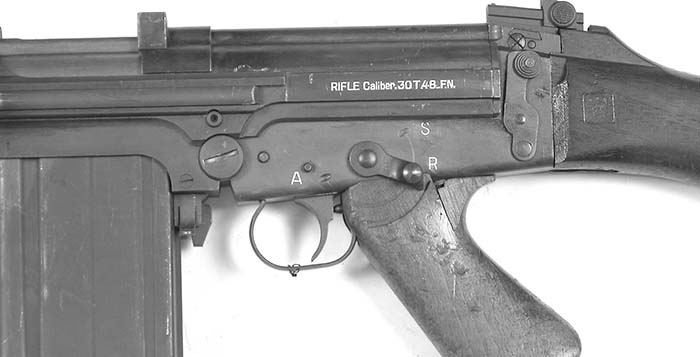
There was a great deal of skepticism on behalf of those involved in the testing about the United States Army adopting a foreign designed infantry weapon for its forces. Many felt that the U.S. Ordnance Department was simply going through the motions of testing the FAL rifle to appease the other NATO members, who were pressuring the U.S. to adopt the Belgian rifle. On the other hand, there was great political pressure from the U.S. Army and the Springfield Armory to adopt the U.S. designed T44E4.
After the trials were completed, Fort Benning reported that both rifles were suitable for army use, failing to decisively choose one design over the other. The U.S. Marine testing at Quantico reported that the Springfield Armory’s T44E4 rifle entry held a slight edge. It seemed as though no one was prepared to select one rifle over the other, as it was becoming a very sensitive political issue.

After a thorough study of all the test reports, which lasted nearly a year, the U.S. Ordnance Department finally came to the conclusion that the U.S. designed T44E4 rifle possessed the following advantages;
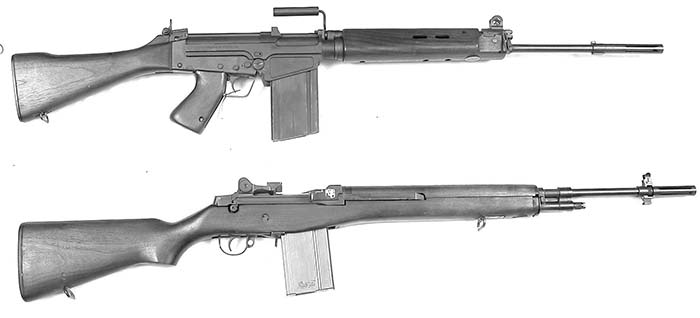
- The T44E4 rifle was a full pound lighter than the T48.
- The T44E4 contained fewer parts and had a single-port gas system that didn’t require adjustments.
- The similarities between the T44E4 and its predecessor, the M1 Garand rifle, would ease both training and manufacturing requirements.
Despite pressure from the other NATO countries for the U.S. to adopt the Belgian designed T48 rifle, on 1 May 1957 Secretary of the Army Wilbur H. Bruckner announced that the T44E4 and T44E5 were being adopted as the Standard U.S. service rifles as the M14 and M15 respectively. An Ordnance Committee meeting held on 14 November 1957 finalized the adoption of the M14 and M15 rifles as Standard.
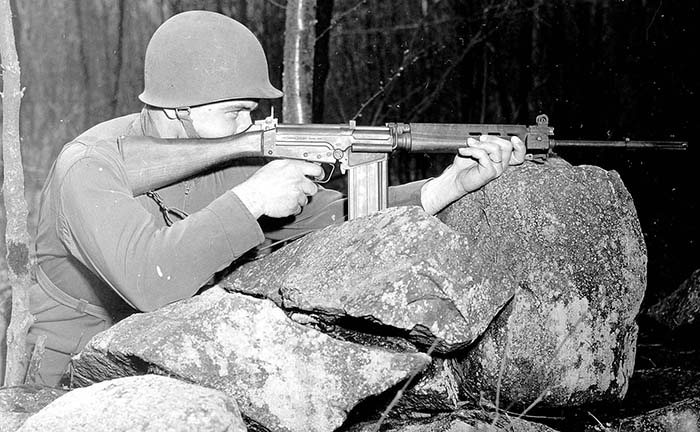
The Belgian FAL rifle, in slightly varying configurations, was eventually adopted as the standard infantry rifle by over ninety countries. The FAL would become the most prolific rifle among the NATO alliance, and made in far larger quantities than any other 7.62mm rifle.
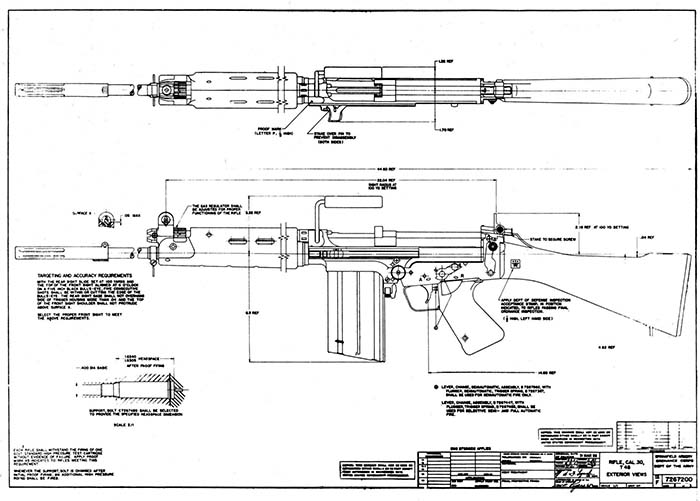
(Courtesy of Bill Ricca)
| This article first appeared in Small Arms Review V9N9 (June 2006) |










